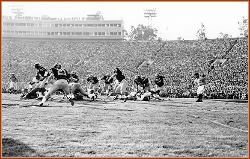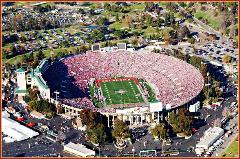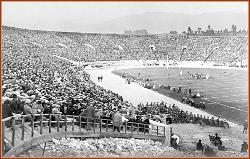



Mile High Stadium (known as Bears Stadium until 1968) was a baseball, soccer and football stadium that stood in Denver, Colorado from 1948-
2001. It hosted the Denver Broncos of the NFL from 1960-2000, the Colorado Rockies of the NL from 1993-1994, the Colorado Rapids of MLS
from 1996-2001, the Denver Gold of the USFL from 1983-1985, and the Denver Bears and Denver Zephyrs of minor league baseball's Western
League, American Association and Pacific Coast League from its completion in 1948 until 1992.
Mile High Stadium was originally built as Bears Stadium for minor league baseball by Bob Howsam in 1948 on top of an old dump. The stadium
initially consisted of a single 17,000-seat grandstand stretching along the north side from the left field foul pole to the right field foul pole on the
west side.
In the late 1950s there was an attempt to form the Continental League lead by the famous Dodger General Manager, Branch Rickey. Bob
Howsam joined ranks with Rickey, pleading for a major league team in Denver. Advised that to get a major league franchise Denver would need
a much larger ballpark, Bear Stadium would begin the first of its many expansions. Over eight thousand seats were added to the south stands,
bringing stadium capacity to 23,100. The new east stands increased seating to 34,657. The final bill, including cost overruns, came to just under
$500,000.
Major League Baseball’s answer to the Continental League was to expand the league, which would eventually lead to the folding of the
Continental League. Although Denver was not awarded a franchise, MLB promised teams in the future for Denver and other cities. Howsam was
now trapped with a large stadium and debt he could not afford. Frantically searching a solution he turned to football. After meeting Lamar Hunt,
Bud Adams, and George Halas, Howsam helped form the American Football League (AFL) and Denver was awarded the Broncos. A large
bleacher section was added along the south side and temporary east stands were built in 1960, raising the capacity to 34,000.
Howsam's ownership in the AFL was short-lived as overwhelming debt forced Howsam to sell all his sports interests in 1961. His dream of major
league baseball in Denver would be placed on hold for another 30 years. The stadium was sold to the city in 1968, which renamed it Mile High
Stadium and built the upper deck along the west side, raising capacity to 50,000.
Denver had to settle for the minor league Bears and the AFL Broncos who resembled the early New York Mets version of football. Looking
comical in their yellow & black vertical stripped socks, mustard yellow and brown uniforms, the fans in the stands would sing, "Send in the
Clowns" when the Broncos would take the field. It took a few years to gain a following. In 1961 they drew fewer fans in a year than the Broncos
now draw in a single game. In the middle of the 1960s uniforms changed, there were some wins, attendance turned around and people caught
Bronco Fever.
As ticket sales increased, the stadium expanded to 51,706 seats. With a $25 million bond issue in 1974 another stadium renovation added
20,000 more seats. By 1975 seating was up to 75,100. An ingenious expansion that took place from 1975-1977 raised the capacity to nearly
80,000 by extending the upper deck along the north side and building a movable triple-decked stands along the east side. When fully extended,
the stands would form a horseshoe for football, but when fully retracted by 145 feet (44 m), the stadium could still fit a normal-sized baseball
field. The structure was 535 feet (163 m) long, 135 feet (41 m) tall and 200 feet (61 m) deep, weighing nearly 90 million pounds (45,000 t). In
order to move the stands over more than 90,000 square feet (8,000 m²) of runways, water was pumped onto the runways and formed a .003
inch (76 micrometre) sheet upon which the stands rested. Hydraulic rams then pushed the stands forward at the rate of three feet per minute (15
mm/s), taking about two hours from start to finish. In 1986, 77 luxury suites were added atop the west stands, increasing the official seating
capacity to 76,123.
The large size of the stadium ensured that the expansion Rockies were able to set Major League Baseball attendance records before moving to
Coors Field for the 1995 season. Indeed, the stadium was known for its loudness, the sound bouncing around within the horseshoe. Because of
the huge size of the outfield and foul territory, as well as the 30-foot (10 m) high fence in center field, the stadium was not as problematic for
pitchers as Coors Field proved to be.
On October 1, 2000, Broncos fans sustained the world’s loudest roar for 10 seconds, with a reading of 128.74 decibels, beating the previous
world record by 3.34 decibels. Mile High Stadium was closed in 2001 after the Denver Broncos and Colorado Rapids moved to neighboring
INVESCO Field at Mile High. It was demolished in January 2002.






